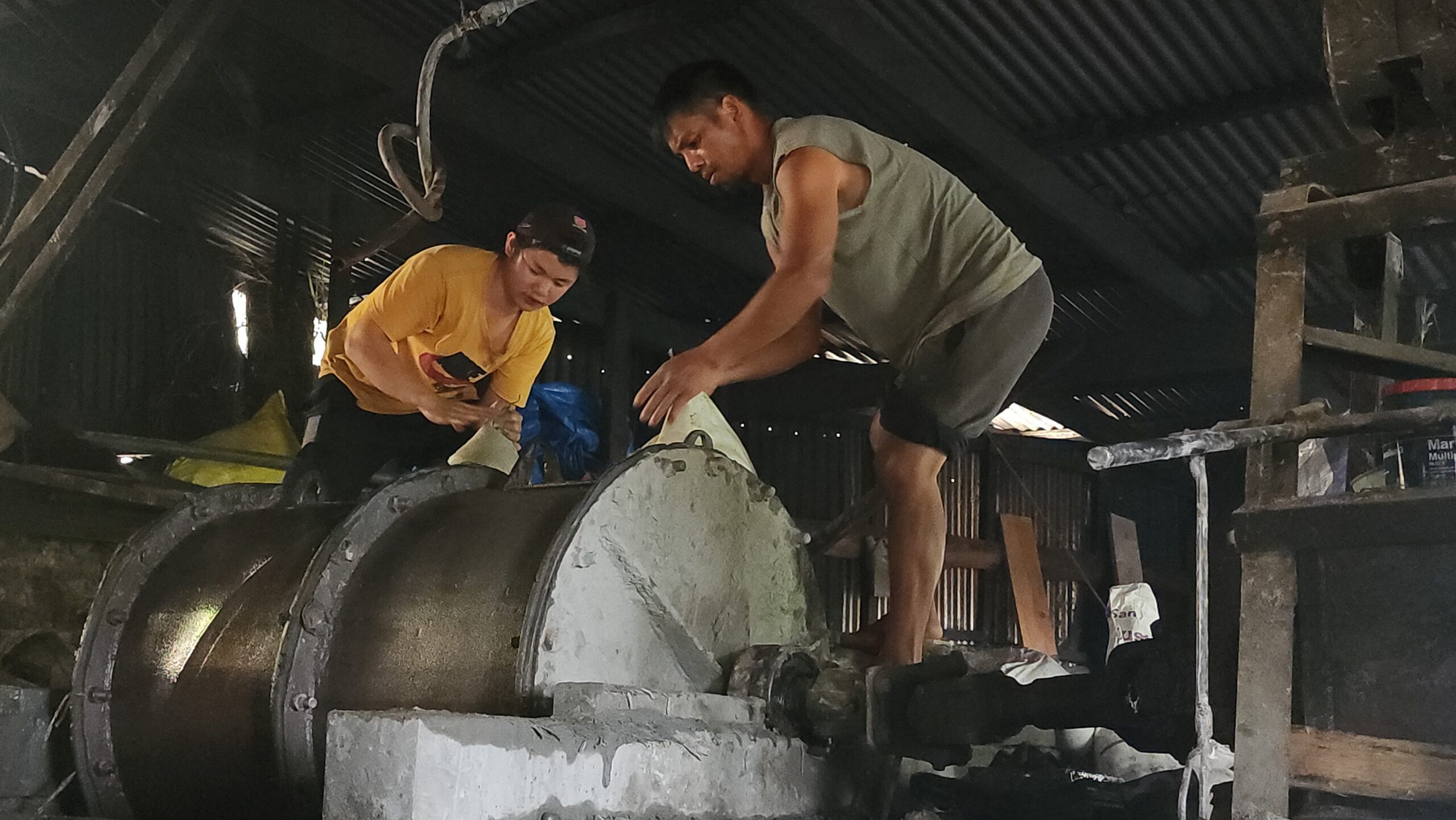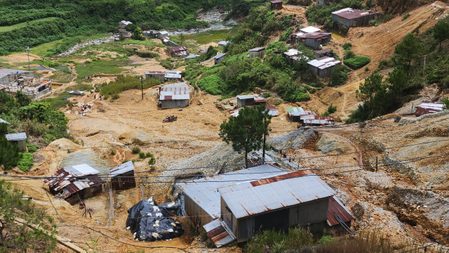SUMMARY
This is AI generated summarization, which may have errors. For context, always refer to the full article.

SAGADA, Philippines – Tax and labor law issues, and a clash between new and traditional operating methods challenge the Northern Sagada Barangays Small Scale Miners Association, Inc. (NSBSSMAI) even after the renewal in September of its two-year contract with the government.
NSBSSMAI president Matthew Malicdan many miners resist the legal requirement for a centralized mill processing facility within the Minahang Bayan in Barangay Fidelisan.
NSBSSMAI is one of only two registered Minahang Bayan with government contracts. Eleven others struggle with the regulatory process.
The village currently has 20 operating mills, including one owned by Malicdan.
“I doubt that they will agree to close their mills,” Malicdan told Rappler on September 26. Most miners have invested millions in their facilities, he pointed out.
Ban on cyanide
A central mill is under construction with funding from the Global Opportunities for the Long-term Development of Artisanal and Small-scale Gold Mining Sector (planetGOLD).
The plant’s original operations model prescribed the use cyanide, which is allowed but regulated under DENR Administrative Order No. 97-39.
However, the community’s long-standing ban on chemical use in the mines forced proponents to install a gravimetric gold separator aligned with the traditional gold extraction method of combining sluice boxes and panning.
The process leaves up to 40 percent gold content in the mill tailings. Miners then sell collected mine tailings to licensed processors to extract the remaining gold.
Tax issues
The province also needs to revise its revenue code to include the fees for small-scale mining (SSM), according to Wilma Chalotog of the Mountain Province Environmental and Natural Resources Office.
The Provincial Mining Regulatory Board started operations in 2012, two decades after the government enacted RA 7076 or the People’s Small-Scale Mining Law of 1991.
Under the law’s revised implementing rules and regulations, the provincial or city government may pass ordinances imposing other fees on mineral processing.
The province currently collects fees based on DENR Administrative Order No. 22-03. These include a P10,000 application and renewal fee, P300 registration for each miner, and P75 per ton of mine tailings for the ore transport permit.
The municipal government has also charged NSBSSMAI for the first time with a P1,363 business tax and P15,000 for the mayor’s permit.
Sagada local treasury officer Nelson Lab-as said the town should review the revenue code to include SSM, “hoping that now they are formalized, there would be concrete returns to the local wealth.”
Section 34 of RA 7076’s implementing rules also mandates the collection of P100 per hectare Occupation Fee to be paid to the municipality where the SSM contract is located.
Chalatog described most LGU activities as “limited to monitoring the permitting process.”
Environment and Natural Resources Secretary Roy Cimatu ordered the closure of all SSM in the Cordillera in 2018 after a landslide killed at least 94 small miners in Itogon, Benguet at the height of Typhoon Ompong.
The crackdown forced small miners to register under the government’s Minahang Bayan program based on a 2012 Executive Order signed by then president Benigno Simeon Aquino III.
Community safeguards
The community mine site dates back to 1986. Policies have evolved through the years, including prioritizing work for members of the Pidlisan and Tanulong tribes occupying six northern barangays of Sagada.
If there is a dearth in labor, they open hires to residents of other towns.
Barangay captain Peter Patong said the miners association, elders, and community have consistently enforced the rules, “with violations resulting to fines, tunnel closures, and even suspension of all work in the mining site.”
Community guidelines limited the expansion of the mines, which are located at the foot of the ridge where Fidelisan is nestled.
The community also prohibited the use of explosives and chemicals, the use of child labor in the tunnels, and anti-social activities like gambling, drinking, and stealing.
Communal rules “maintain both safety and order in the mines and have lessened the impact on the environment,” Patong said.
Chalotog recognized the efforts of the community’s “good practice” to regulate the impact of the mines.
Labor laws
Integrating traditional ownership models and labor laws remains a puzzle, however.
Tunnel operators interviewed by Rappler said there is no defined employee-employer relationship in the mines. Most operate like a family or clan enterprise, where every member plays a role, including ensuring safety rules.
Work time is flexible though the general requirement is at least eight hours, including breaks. The most common arrangement is two to three shifts a day, with an average of seven miners working the tunnels per shift. After stacking enough ore, SMS operators shift to milling, with almost the same arrangement.
After subtracting operational expenses, including food, electric bills, fuel, and mill rent, the remainder is divided equally, with each miner entitled to a share.

Miners’ earnings
Malicdan said a tunnel worker’s share can range from P17/day to P2,500/day, depending on the productivity of the tunnel.
Women usually work in the milling station and during the sluicing of the ore slurry, with daily rates ranging from P300 to P350.
Ownership can be held by a group or an individual, depending on who opened and extensively developed the tunnel. The owner of a tunnel gets an additional share in recognition of individual work and investment.
There are also cases where, instead of rent, the mill also gets a share. If a financier shoulders the operational expenses, he or she will get a share on top of the amount spent for the operation.
These arrangements reflect a highly organized work system but make monitoring of labor law compliance a challenge.
The association has introduced support systems in case of accidents and hospitalizations. However, social benefits like SSS and PhilHealth remain voluntary and paid by individuals.
Controversies
When it operated outside government control, small-mining in Sagada faced opposition and controversies.
Despite the community’s effort to regulate SMS operations, downstream barangays have complained several times since 2000 about the effects of ore-processing chemicals.
In 2007 and 2012, members of the Pidlisan tribe and the affected barangays dismantled or closed the structures and imposed hefty fines.
At least three tunnel operators have also admitted the use of explosives despite community and legal prohibitions because “tunnels are being carved on solid rocks.”
There is no clear database on accidents, but miners estimate that seven to nine individuals have died since 1986. Other incidents resulted in minor injuries.
Despite the challenges, Malicdan and Patong are hopeful that the community eventually integrate government regulations while tightening traditions that protect the community. – Rappler.com
Add a comment
How does this make you feel?










![[OPINION] Grading Marcos admin’s performance on the climate agenda](https://www.rappler.com/tachyon/2024/06/grading-marcos-performance-climate-agenda-june-25-2025.jpg?resize=257%2C257&crop=441px%2C0px%2C1080px%2C1080px)





There are no comments yet. Add your comment to start the conversation.